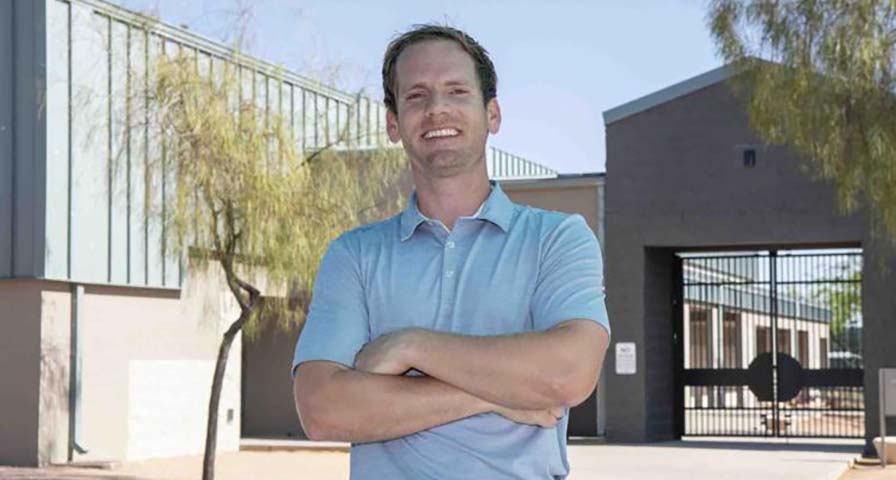Originally published June 6, 2021 in the Scottsdale Progress.
By Kristine Cannon
After winning the Arizona Heath and Physical Education Innovative Teacher of the Year award in 2019, Anasazi Elementary physical education teacher Kyle Bragg has not one, but two more awards to add to his ever-increasing collection of achievements this year.
He earned the Shape America Western District Elementary Physical Education Teacher of the Year, and Shape America National Elementary Physical Education Teacher of the Year.
 “It means a lot,” Bragg said. “It’s a great time for advocating for getting the word out about the importance of developing the whole child.”
“It means a lot,” Bragg said. “It’s a great time for advocating for getting the word out about the importance of developing the whole child.”
The awards recognize outstanding teaching performance and the ability to motivate today’s youth to participate in a lifetime of physical activity, Shape America’s press release states.
Celebrating his 10th year of teaching – his fifth at Anasazi – Bragg is a national board-certified teacher who integrates both technology and social emotional learning (SEL) into his PE program to create developmentally appropriate lessons.
“We’re doing a lot more than just the physical skills,” Bragg said. “We’re learning social-emotional learning, problem solving and things that can be transferred in other settings. So, I’m really proud of our kids.”
Named among six other educators across the country as 2021 Teachers of the Year in Physical Education, Adapted PE, Health and Dance, Bragg said what sets him apart as an educator is his ability to teach and develop the “whole child.”
“We’re constantly integrating content standards, like math and reading,” Bragg said.
He prides himself in ensuring the kids feel not just physically safe but also emotionally safe in and out of the classroom.
“So, when they come in, regardless of how talented or skilled they are at sports or activities like that, they’re going to feel comfortable and loved – and they’re going to do their very best,” he said.
This is social-emotional learning.
It “enhances the students’ ability to succeed in school – and beyond – by teaching them how to self-regulate their emotions, problem solve, make responsible decisions, maintain positive friendships, and more,” Bragg explained.
For example, instead of praising a student for hitting a baseball far into the outfield, Bragg will praise the student for their eye contact or their ability to stay positive.
“Those are the things that people really appreciate,” he said. “So, whenever they come, they’re ready emotionally versus, ‘Oh my gosh. I’m worried that I might not be as good.’ Because we’re a team here, and we accomplish things.”
The pandemic proved challenging, at first, for Bragg, who had to pivot to online learning during quarantine.
“We had to obviously get out of our comfort zone,” he said.
After turning to Twitter, however, he was able to collaborate with fellow educators all over the world to exchange ideas on how they can work smarter, and not harder, as a distanced P.E. teacher.
“We’re all willing to help each other,” he said.
During online learning, Bragg utilized plenty of apps, like Flipgrid, Edpuzzle and Jamboard, that allowed the students to take part in interactive lessons and at their own pace.
“For example, with Edpuzzles, they pause every minute or so to answer a question and then they’ll do it. So, let’s say they’re trying to learn how to catch.
“The question might be, ‘Where should your hands be positioned when you’re catching and then they would type it in and then they would practice it and come back and press play again?’ It’s really cool and interactive.”
Bragg got creative with his lessons, too.
He’d ask the students to use anything around the house, like bedsheets or cups, to help them stay active and maximize their activity time.
And when the students returned to in-person learning, Bragg was still challenged with coming up with ways to keep them active in a socially distanced, hands-free way.
Instead of playing foursquare with a ball, for instance, the students would count down and run to a new corner.
Instead of playing tag, where you’d traditionally touch the other person, the students would “tag” each other’s shadows.
“It’s just trying to be creative and active without any equipment,” Bragg said.
The Anasazi students may be back to in-person learning, but that doesn’t mean Bragg ditched the lessons he taught or the technology he utilized amid the pandemic.
Instead, he said, he’ll use them to help keep physically absent students involved and engaged from afar.
“What I’m really proud about is I have four months’ worth of lessons that are distance learning or online learning lessons,” Bragg said.
“So, if students can’t get to school, whether their parents are taking them out of town or whether they have doctor’s appointment, they might be missing the actual lesson in person, but I can post these online lessons they’re still able to do exactly what we’re doing,” he said.
Bragg credits the pandemic for not only pushing him outside of his comfort zone, but for also helping him grow professionally.
“It also made me reflect on my teaching and talk about what’s working, what’s not,” he said. “And every time you reflect, you grow as a teacher. And that helps our students.”
Learn How the IHT Spirit System Encourages Physical Activity in School-Age Children:




